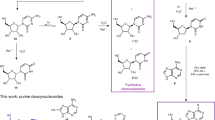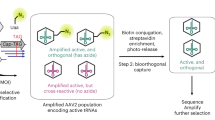Abstract
TRANSFORMATION of bacterial cells in the presence of deoxyribonucleic acid (DNA) has been demonstrated1–3, and has indicated that genetic information is carried by DNA. There is little unequivocal evidence for such transformations in higher forms of life, in contrast to the obvious transfer of genetic information that occurs by means of the gamete during fertilization. The two reported attempts to obtain these transformations through the mediation of added DNA have been conflicting4,5. On the other hand, evidence for the uptake of DNA by mammalian cells6,7 has supported the idea that observed biological effects might be obtained. In this communication I present evidence for the incorporation of extracellular high molecular weight DNA into the nuclear DNA of cells of the Ehrlich–Lettré ascites tumour, when they are incubated in vitro (Table 1). Labelled homologous DNA for these experiments was first obtained by injecting formate labelled with carbon-14 intraperitoneally in mice bearing this tumour. After an appropriate time-interval, the tumour cells were removed and washed and the DNA isolated by the detergent procedure8. To determine the specific activity of the DNA used in the experiments, samples were hydrolysed with 70 per cent perchloric acid for 1 hr. at 100° C. and the bases, adenine and thymine, separated by paper chromatography using a solvent system of isopropanol, hydrochloric acid and water. The bases were eluted and the specific activity of each was determined for appropriately plated samples using a gas-flow counter for the radioactivity determinations.
This is a preview of subscription content, access via your institution
Access options
Subscribe to this journal
Receive 51 print issues and online access
$199.00 per year
only $3.90 per issue
Buy this article
- Purchase on Springer Link
- Instant access to full article PDF
Prices may be subject to local taxes which are calculated during checkout
Similar content being viewed by others
References
Avery, O. T., MacLeod, C. M., and McCarty, M., J. Exp. Med., 79, 137 (1944).
Catlin, B. W., and Cunningham, L. S., J. Gen. Microbiol., 19, 522 (1958).
Zinder, N. D., and Lederberg, J., J. Bacteriol., 64, 679 (1952).
Benoit, J., Leroy, P., Vendrely, C., and Vendrely, M. R., C.R. Acad. Sci., Paris, 247, 1049 (1958); Trans. N.Y. Acad. Sci., II, 22, 494 (1960).
Medawar, P. B., Nature, 182, 62 (1958).
Gartler, S. M., Nature, 184, 1505 (1959).
Chorazy, M. R., Baldwin, H. H., and Boutwell, R. K., Fed. Proc., 19, 307 (1960).
Kay, E. R. M., Simmons, N. S., and Dounce, A. L., J. Amer. Chem. Soc., 72, 1724 (1952).
Kay, E. R. M., Fed. Proc., 19, 393 (1960).
Smellie, R. M. S., Humphrey, G. F., Kay, E. R. M., and Davidson, J. N., Biochem. J., 60, 177 (1955).
Author information
Authors and Affiliations
Rights and permissions
About this article
Cite this article
KAY, E. Incorporation of Deoxyribonucleic Acid by Mammalian Cells in vitro . Nature 191, 387–388 (1961). https://doi.org/10.1038/191387a0
Issue Date:
DOI: https://doi.org/10.1038/191387a0
This article is cited by
-
Gene and virotherapy for hematological malignancies
International Journal of Hematology (2016)
-
A brief history of gene therapy
Nature Genetics (1992)
-
Effect of exogenous DNA on content and biosynthesis of endogenous DNA in rat bone marrow
Bulletin of Experimental Biology and Medicine (1976)
-
Incorporation of exogenous DNA into mammalian chromosomes
Nature (1974)
-
Influence of exogenous DNA on Ypenyl-treated chromosomes ofVicia faba L.
Biologia Plantarum (1969)
Comments
By submitting a comment you agree to abide by our Terms and Community Guidelines. If you find something abusive or that does not comply with our terms or guidelines please flag it as inappropriate.



